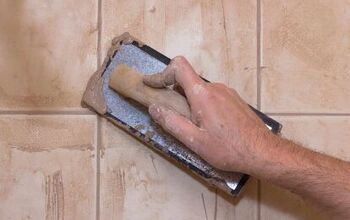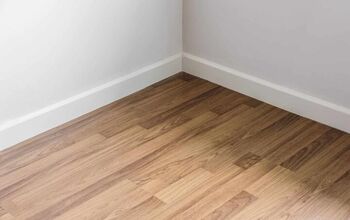Will Tacky Stain Eventually Dry? (We Have The Answer)

Staining wood can bring out some of its natural patterns and deep colors like nothing else. If you want to change a wood surface’s color without painting it, staining is a great option. However, stain must be properly applied otherwise it will not dry and still feel sticky and rough hours later.
If the stain is still tacky 12 hours after applying it, it will not eventually dry. Stain penetrates wood but if it can’t due to excess stain or dirt, it will sit on top without drying. You will either have to sand it or apply another coat of stain to loosen it and wipe it off.
One of the best things about wood is that it is malleable. It is forgiving with mistakes and the finish stage is no exception. If your stain is not drying, don’t fret. There are still opportunities to fix it and in this article, we will cover a few of them.
Related Content: How To Dry Wood Stain Faster | How Long Does Wood Stain Take To Dry? | Deck Stain Not Drying?
Do You Need to Hire a Paint Contractor?
Get free, zero-commitment quotes from pro contractors near you.

Stain Vs. Varnish
In this article, we will discuss what to do if your stain is tacky and not drying. Here, it is important to know the difference between stain and varnish. Often, the two get mixed up and the confusion should be cleared up.
Varnish is a clear finish that adds a smooth, shiny sheen to wood surfaces. It does not usually change the color of the wood, it just gives it a clear coat and protective shine. Tacky varnish will eventually dry since it is meant to dry over the top of the wood.
Stain is a thin type of paint that is meant to get inside the woodgrain and change the color. It does not dry on top with a shiny finish. If you still have a stain on the wood, it will not dry and must be removed and re-stained.
Types of Stain
Oil-based
Oil-based stains are common types of wood stains and are known for their durability. Linseed oil is a popular oil stain and can offer layers of protection on most types of wood. They usually contain synthetic pigments and can deeply penetrate wood.
Water-based
These stains use water instead of thinners to break up the dyes and get them into the wood. They will be much less likely to stay tacky after more than a few hours. These types have the most penetrating power.
Lacquer
Lacquer stains are thick and similar in viscosity to varnishes. Though they dry quickly, they are the most likely to sit on the surface of the wood. To use a lacquer stain, make sure that your wood surface is completely clean and sanded.
Water-Soluble Dye
These stains come in powdered form and must be mixed with distilled water. No matter how many coats you apply, these will not completely change the wood’s color. They are also not likely to stay sticky after drying.
Why Does Stain Get Tacky?
Stain gets tacky when it is not able to completely soak into the actual fibers of the wood. Stain is a dye but it can not just cover up flaws. It works with the natural form of the wood to change the color from the inside. Unless, of course, it can’t get inside.
One of the most common reasons why stain gets tacky after drying is that the wood hasn’t been cleaned. You must wipe down your wood with a wet cloth before staining. Make sure that any sawdust has been cleared away and that the surface is completely clean.
Your stain may also get tacky if the wood isn’t sanded. The surface must be smooth enough to allow for an even penetration. If it isn’t even, the stain will build on top of itself and stay sticky on top of the surface.
How Do I Dry Tacky Stain?
If you have applied a stain and 12 or more hours later it is still tacky, don’t panic. There are ways to remedy the situation. It will require more work but you should be able to turn the project around.
The first thing you can do is completely sand down the project again. This will remove any of the tacky stain and make sure you have a clean surface to apply a new coat too. This is the most time-consuming option but the most effective.
The other thing you can do is apply another coat and wipe it down before it dries. This will bring up any excess stain as well as any dust that was keeping it from penetrating the wood. After the excess is removed, let it dry and see if you need another coat.
How Do I Apply Stain Correctly?
To avoid having any of the above issues, you should try to apply stain as evenly and sparingly as possible. Before you begin, sand down the wood with a light sandpaper. Then, wipe it down with a wet cloth.
After that has dried, apply the stain with a bristle brush or cloth. Work the stain into the pores of the wood and make sure there’s no excess building up in any cracks. After a few minutes, wipe the surface down with a dry towel to remove any excess that you missed.
After 1 hour or so, sand down the wood again and wipe it down with the same wet cloth. Repeat the above process, making sure that no stain is building up or dripping. Do this until you achieve the desired deepness and richness of color.
Tools Needed for Staining
Shop Cloths
Shop cloths are usually cheap, woven cloths that are perfect for applying stain or cleaning surfaces. Having a few clean ones handy will keep your project clean.
Brushes
Bristle brushes are a good way to work the stain into small, detailed areas. Some oil-based stains don’t spread as well with brushes, though.
Stain of Choice
There are seemingly endless varieties of stain that you can use to color wood surfaces. Knowing the type of wood you are trying to stain will help you choose one. Some of them react better to certain types of wood than others.
Best Environment for Staining
Any kind of painting or staining will work best in dry conditions. This is always something that you should consider when starting a painting or staining project. If there is a lot of moisture in the air, the stain will not dry as well. In that case, it may be better to wait for a sunny day.
When working with stains, always be sure to work in a ventilated area. Even water-based stains can have undesirable chemicals in them. It is always best to do the safe thing first and not have to worry about it later.
Do You Need to Hire a Paint Contractor?
Get free, zero-commitment quotes from pro contractors near you.

Related Questions
What happens if you apply a second coat of stain too soon?
Applying the second coat too soon could increase your risk of getting a tacky finish. This could clog up the pores of the wood and make it impossible to soak up the color. Always wait at least an hour between coats.
Can you stain over stain?
If you are applying a darker stain over a lighter stain, you can absolutely do it. Combining and experimenting with stain colors could also yield some interesting results. Just be sure to do experiments on pieces of wood you’re not worried about ruining.
Will mineral spirits remove wood stain?
Mineral spirits can help lighten a stain that is too dark but they can not remove it. To apply the mineral spirits, put it on a clean cloth and rub it into the grain of the wood. Rinse with water after every application of the mineral spirits.
Related Guides

I am a writer and editor from The Bay Area, CA. When I'm not typing, I enjoy hiking, woodworking and gardening. I love sharing tips and discovering new trends in home improvement.
More by Michael Oconnor



























